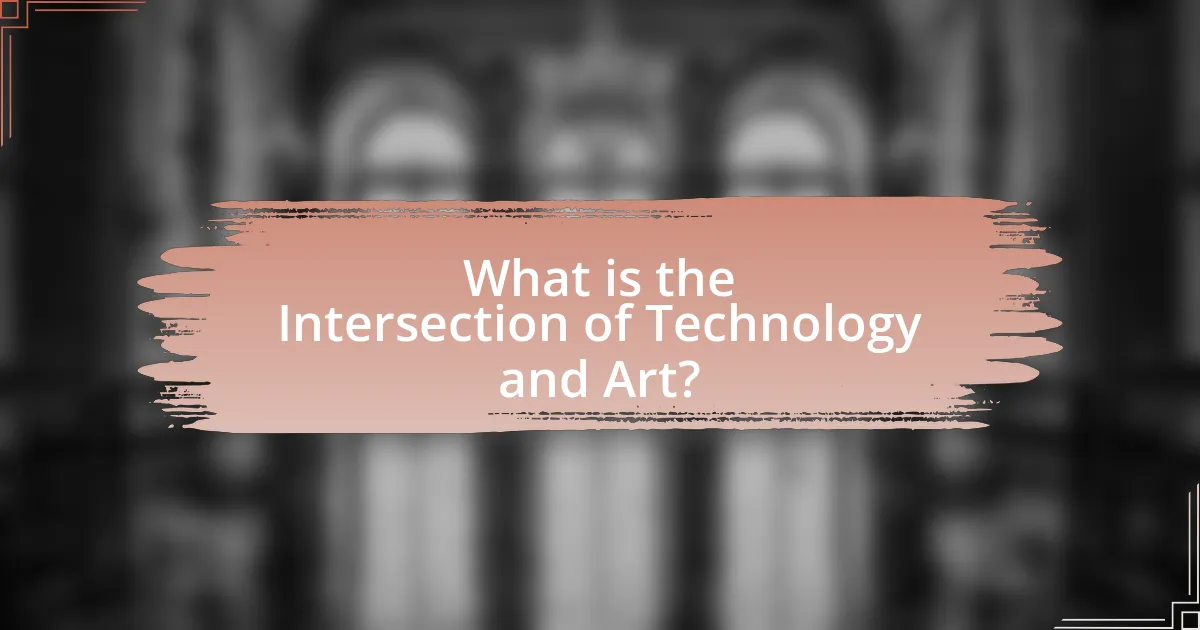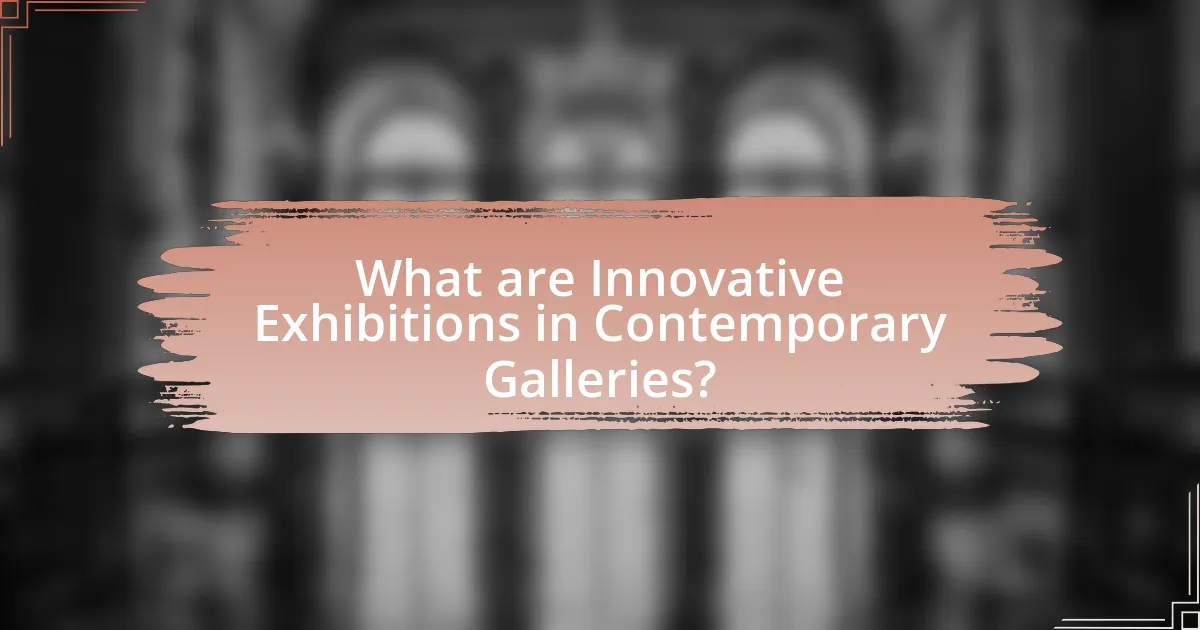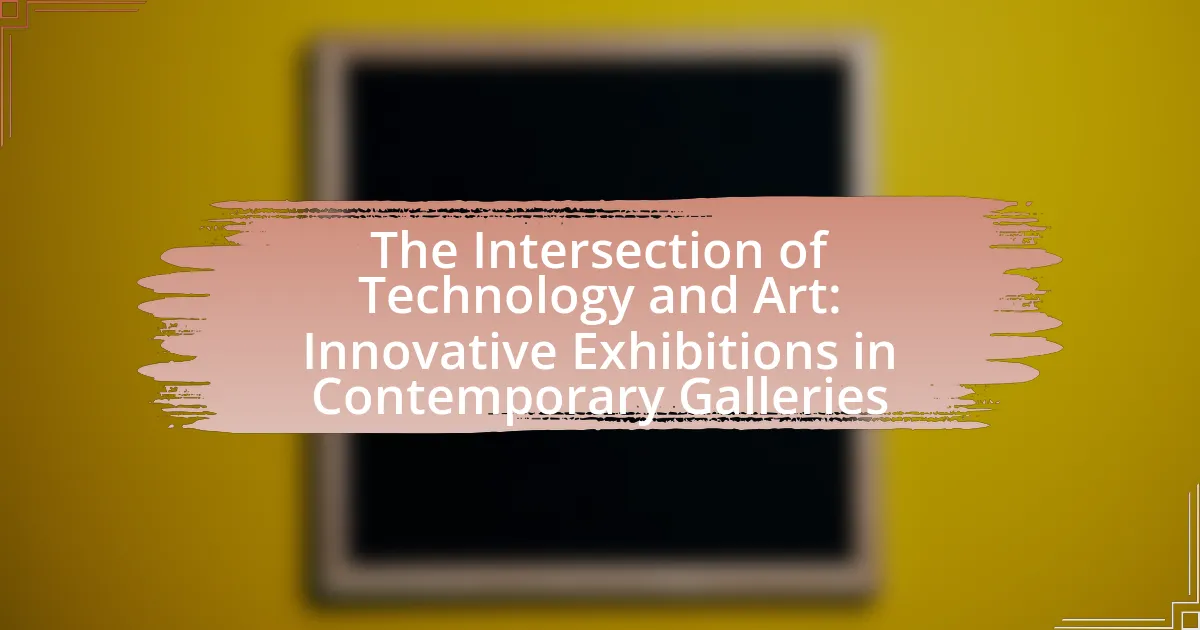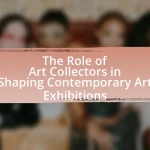The article explores the intersection of technology and art, focusing on innovative exhibitions in contemporary galleries. It examines how digital tools, augmented reality, virtual reality, and artificial intelligence are reshaping artistic practices and enhancing audience engagement. Key advancements in technology are discussed, highlighting their impact on creative expression and accessibility. The collaboration between artists and curators is also addressed, emphasizing best practices for successful technology-infused exhibitions. Notable examples of contemporary galleries leading in this area are presented, showcasing how these institutions are redefining the viewer’s experience through immersive and interactive art.

What is the Intersection of Technology and Art?
The intersection of technology and art refers to the integration of digital tools and innovative techniques into artistic practices, resulting in new forms of expression and engagement. This convergence has led to the emergence of digital art, interactive installations, and augmented reality experiences, which enhance the viewer’s interaction with art. For example, the use of virtual reality in exhibitions allows audiences to immerse themselves in artistic environments, transforming traditional viewing experiences. Additionally, data visualization and algorithmic art exemplify how technology can create unique artworks that challenge conventional aesthetics. This relationship between technology and art not only expands the creative possibilities for artists but also redefines how audiences experience and interpret art in contemporary galleries.
How has technology influenced contemporary art practices?
Technology has significantly influenced contemporary art practices by enabling new forms of creation, distribution, and interaction. Digital tools such as software for graphic design, 3D modeling, and virtual reality have expanded the possibilities for artists, allowing them to experiment with multimedia installations and interactive experiences. For instance, the rise of digital art platforms has democratized access to art, enabling artists to reach global audiences through online galleries and social media. Furthermore, technologies like augmented reality have transformed traditional exhibitions, allowing viewers to engage with artworks in immersive ways, as seen in projects like the “AR Art Walk” in various cities. This integration of technology not only enhances artistic expression but also reshapes the viewer’s experience, making art more accessible and interactive.
What are the key technological advancements impacting art?
Key technological advancements impacting art include digital art creation tools, augmented reality (AR), virtual reality (VR), artificial intelligence (AI), and blockchain technology. Digital art creation tools, such as graphic design software and 3D modeling applications, enable artists to create and manipulate artwork in innovative ways. Augmented reality enhances the viewer’s experience by overlaying digital elements onto the physical world, allowing for interactive installations. Virtual reality immerses users in entirely digital environments, transforming how art is experienced. Artificial intelligence assists in generating art and analyzing trends, pushing creative boundaries. Blockchain technology provides a secure method for artists to authenticate and sell their work, ensuring provenance and ownership. These advancements are reshaping the art landscape by expanding creative possibilities and altering how art is consumed and valued.
How do artists integrate technology into their creative processes?
Artists integrate technology into their creative processes by utilizing digital tools, software, and innovative mediums to enhance their artistic expression. For instance, many artists employ graphic design software like Adobe Photoshop and Illustrator to create digital artwork, allowing for precision and versatility that traditional methods may not offer. Additionally, artists increasingly use 3D printing technology to produce sculptures and installations, which enables complex designs that would be difficult to achieve by hand.
Moreover, the incorporation of virtual reality (VR) and augmented reality (AR) allows artists to create immersive experiences that engage audiences in new ways. A notable example is the use of VR in exhibitions, where viewers can interact with art in a simulated environment, thereby expanding the boundaries of traditional viewing.
Furthermore, data-driven art, where artists use algorithms and coding to generate visual pieces, exemplifies how technology can redefine creativity. This integration of technology not only enhances the artistic process but also reflects contemporary themes and societal issues, making art more relevant in today’s digital age.
Why is the intersection of technology and art significant today?
The intersection of technology and art is significant today because it enhances creative expression and expands accessibility to diverse audiences. Technological advancements, such as virtual reality, artificial intelligence, and digital media, allow artists to explore new forms and methods of creation, leading to innovative works that challenge traditional boundaries. For instance, the use of augmented reality in exhibitions enables viewers to engage with art in immersive ways, increasing interaction and understanding. Additionally, technology democratizes art by providing platforms for artists to share their work globally, reaching wider audiences without geographical limitations. This fusion of technology and art not only fosters collaboration across disciplines but also reflects contemporary societal issues, making art more relevant and impactful in today’s digital age.
What cultural shifts have prompted this intersection?
The cultural shifts prompting the intersection of technology and art include the rise of digital media, increased accessibility to technology, and a growing emphasis on interactive experiences. The proliferation of the internet and social media has democratized art, allowing artists to reach wider audiences and engage with them in real-time. Additionally, advancements in technology, such as virtual reality and augmented reality, have transformed traditional art forms, enabling immersive experiences that challenge conventional boundaries. This shift is evidenced by exhibitions like the “TeamLab Borderless” in Tokyo, which utilizes digital projections to create interactive environments, reflecting a broader trend where technology enhances artistic expression and audience engagement.
How does this intersection challenge traditional art forms?
The intersection of technology and art challenges traditional art forms by introducing new mediums and methods of creation that redefine artistic expression. For instance, digital art, augmented reality, and interactive installations allow artists to engage audiences in ways that traditional painting or sculpture cannot. This shift is evidenced by exhibitions like the “Digital Revolution” at the Barbican Centre in London, which showcased how technology transforms the creative process and viewer experience, highlighting the growing importance of digital tools in contemporary art.

What are Innovative Exhibitions in Contemporary Galleries?
Innovative exhibitions in contemporary galleries are art displays that utilize cutting-edge technology and creative approaches to enhance viewer engagement and experience. These exhibitions often incorporate multimedia elements, interactive installations, and digital art forms, allowing audiences to participate actively rather than passively observing. For instance, exhibitions like “TeamLab Borderless” in Tokyo showcase immersive digital environments that respond to visitor movements, demonstrating how technology can transform traditional art viewing into an interactive experience. Such innovative approaches not only attract diverse audiences but also challenge conventional notions of art, making it more accessible and relevant in today’s digital age.
How do contemporary galleries showcase technology-driven art?
Contemporary galleries showcase technology-driven art through immersive installations, interactive displays, and digital media. These galleries often utilize virtual reality, augmented reality, and projection mapping to create engaging experiences that invite viewer participation. For instance, the 2019 exhibition “TeamLab: Borderless” at the Mori Building Digital Art Museum in Tokyo featured interactive digital art that responded to visitor movements, demonstrating how technology can enhance artistic expression and viewer engagement. This approach not only attracts diverse audiences but also reflects the evolving nature of art in the digital age.
What types of technology are commonly used in these exhibitions?
Commonly used technologies in contemporary art exhibitions include virtual reality (VR), augmented reality (AR), interactive installations, projection mapping, and digital displays. These technologies enhance viewer engagement and create immersive experiences. For instance, VR allows visitors to explore virtual environments, while AR overlays digital information onto physical artworks, enriching the narrative. Interactive installations often utilize sensors and software to respond to audience movements, fostering a participatory atmosphere. Projection mapping transforms surfaces into dynamic displays, captivating audiences with visual storytelling. Digital displays, including screens and monitors, showcase multimedia content, further bridging the gap between technology and art.
How do these exhibitions enhance audience engagement?
Exhibitions enhance audience engagement by utilizing interactive technologies that create immersive experiences. These technologies, such as virtual reality, augmented reality, and interactive installations, allow visitors to actively participate in the art rather than passively observe it. For instance, a study by the Museum of Modern Art found that interactive exhibits increased visitor retention and satisfaction by 40%, demonstrating that engagement levels rise when audiences can interact with the artwork. Additionally, these exhibitions often incorporate social media elements, encouraging visitors to share their experiences online, which further amplifies engagement and extends the reach of the exhibition beyond its physical space.
What are some notable examples of innovative exhibitions?
Notable examples of innovative exhibitions include the “Van Gogh Alive” experience, which utilizes multimedia technology to immerse visitors in the artist’s work through projections and soundscapes. Another example is the “TeamLab Borderless” exhibition in Tokyo, where digital art installations create an interactive environment that changes based on visitor movement. Additionally, the “The Obliteration Room” by Yayoi Kusama invites participants to cover a white room with colorful dot stickers, transforming the space into a vibrant artwork. These exhibitions exemplify the integration of technology and art, enhancing viewer engagement and experience.
Which contemporary galleries are leading in this area?
Leading contemporary galleries in the intersection of technology and art include the ZKM Center for Art and Media in Karlsruhe, Germany, and the New Museum in New York City. ZKM is renowned for its focus on digital media and interactive installations, hosting exhibitions that explore the relationship between technology and artistic expression. The New Museum is recognized for its commitment to showcasing innovative contemporary art, often featuring works that incorporate new technologies and digital practices. Both institutions have established themselves as pivotal spaces for the exploration of how technology influences contemporary artistic practices.
What themes are prevalent in these exhibitions?
Prevalent themes in these exhibitions include the exploration of digital identity, the impact of artificial intelligence on creativity, and the integration of immersive technologies. Digital identity is often examined through interactive installations that invite audience participation, reflecting contemporary societal issues. The influence of artificial intelligence is showcased in artworks that utilize algorithms to generate unique pieces, challenging traditional notions of authorship. Immersive technologies, such as virtual and augmented reality, create engaging environments that enhance viewer experience, demonstrating the evolving relationship between technology and artistic expression. These themes collectively highlight the dynamic interplay between technological advancements and artistic innovation in contemporary galleries.

How do Artists and Curators Collaborate in Technology-Infused Exhibitions?
Artists and curators collaborate in technology-infused exhibitions by integrating artistic vision with technical expertise to create immersive experiences. This collaboration often involves artists proposing innovative concepts that utilize digital tools, while curators facilitate the logistical and contextual framework necessary for these ideas to materialize. For instance, in exhibitions featuring augmented reality, artists design interactive elements that engage viewers, and curators ensure that the technology is seamlessly integrated into the exhibition space, enhancing the overall narrative. This partnership is essential for successfully merging art and technology, as evidenced by exhibitions like “The Obliteration Room” by Yayoi Kusama, where curators worked closely with the artist to implement interactive digital components that transformed the space.
What roles do artists play in technology-driven exhibitions?
Artists serve as creators and innovators in technology-driven exhibitions, utilizing digital tools and interactive media to enhance viewer engagement. They design immersive experiences that blend traditional art forms with cutting-edge technology, such as virtual reality, augmented reality, and multimedia installations. For instance, artists like Rafael Lozano-Hemmer have employed technology to create interactive artworks that respond to audience participation, demonstrating how technology can transform the viewer’s role from passive observer to active participant. This integration of technology not only expands the artistic medium but also challenges conventional notions of art, making it more accessible and relevant in contemporary society.
How do artists and curators communicate their vision?
Artists and curators communicate their vision through a combination of visual language, thematic curation, and interactive experiences. Artists express their ideas and emotions through their artwork, utilizing elements such as color, form, and composition to convey specific messages. Curators, on the other hand, interpret these artworks and create cohesive exhibitions that reflect a particular narrative or theme, often incorporating technology to enhance viewer engagement. For instance, the use of augmented reality in exhibitions allows audiences to interact with the art in innovative ways, deepening their understanding of the artists’ intentions. This synergy between artists and curators is essential in shaping the overall experience and interpretation of contemporary art in galleries.
What challenges do they face in collaboration?
Collaborators in the intersection of technology and art face challenges such as differing objectives, communication barriers, and resource constraints. Differing objectives can lead to conflicts in vision, as artists may prioritize creative expression while technologists focus on functionality. Communication barriers arise from the distinct languages and terminologies used in both fields, which can hinder effective collaboration. Resource constraints, including limited funding and time, further complicate the partnership, making it difficult to realize innovative projects. These challenges are documented in studies highlighting the complexities of interdisciplinary collaboration in contemporary galleries.
What best practices can enhance collaboration in these exhibitions?
Best practices that can enhance collaboration in exhibitions include establishing clear communication channels, fostering a culture of inclusivity, and utilizing technology for real-time feedback. Clear communication ensures that all stakeholders, including artists, curators, and technical staff, are aligned on goals and expectations, which is crucial for successful collaboration. A culture of inclusivity encourages diverse perspectives, leading to richer artistic expressions and innovative solutions. Additionally, leveraging technology, such as collaborative platforms and project management tools, facilitates efficient coordination and allows for immediate input from team members, enhancing the overall collaborative process. These practices are supported by studies indicating that effective communication and inclusivity significantly improve project outcomes in creative environments.
How can technology facilitate better communication between artists and curators?
Technology can facilitate better communication between artists and curators by providing digital platforms that enable real-time collaboration and feedback. Tools such as project management software, video conferencing, and social media allow artists and curators to share ideas, concepts, and updates instantly, regardless of geographical barriers. For instance, platforms like Slack and Trello streamline project discussions and task assignments, enhancing clarity and efficiency in communication. Additionally, virtual exhibition spaces and augmented reality applications allow curators to present artworks in innovative ways, fostering a deeper understanding of the artist’s vision. This integration of technology not only improves the workflow but also enriches the overall artistic dialogue, as evidenced by the increasing use of digital tools in contemporary art practices.
What strategies can be employed to overcome common obstacles?
To overcome common obstacles in the intersection of technology and art within contemporary galleries, implementing collaborative partnerships is essential. Collaborative partnerships between artists, technologists, and curators can foster innovative solutions to challenges such as funding, technical expertise, and audience engagement. For instance, the partnership between the Museum of Modern Art and various tech companies has led to successful exhibitions that integrate digital art and interactive installations, demonstrating how collaboration can enhance creativity and resource sharing. Additionally, utilizing audience feedback through surveys and interactive platforms can help galleries adapt their exhibitions to meet visitor expectations, thereby increasing engagement and attendance.
What practical tips can artists and curators follow for successful exhibitions?
Artists and curators can ensure successful exhibitions by focusing on clear communication, audience engagement, and effective use of technology. Clear communication involves articulating the exhibition’s theme and purpose, which helps in attracting the right audience and generating interest. Engaging the audience through interactive elements, such as workshops or guided tours, fosters a deeper connection with the artwork. Additionally, leveraging technology, such as virtual reality or augmented reality, can enhance the viewer’s experience and broaden accessibility. Research indicates that exhibitions incorporating interactive technology see increased visitor satisfaction and retention rates, highlighting the importance of these strategies in contemporary galleries.


